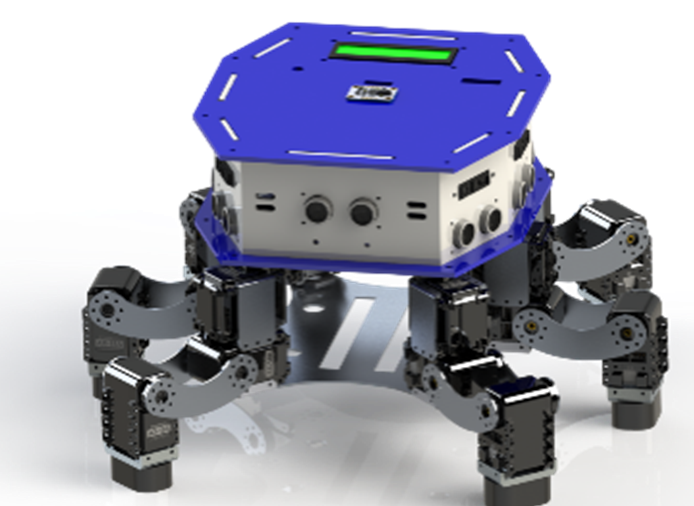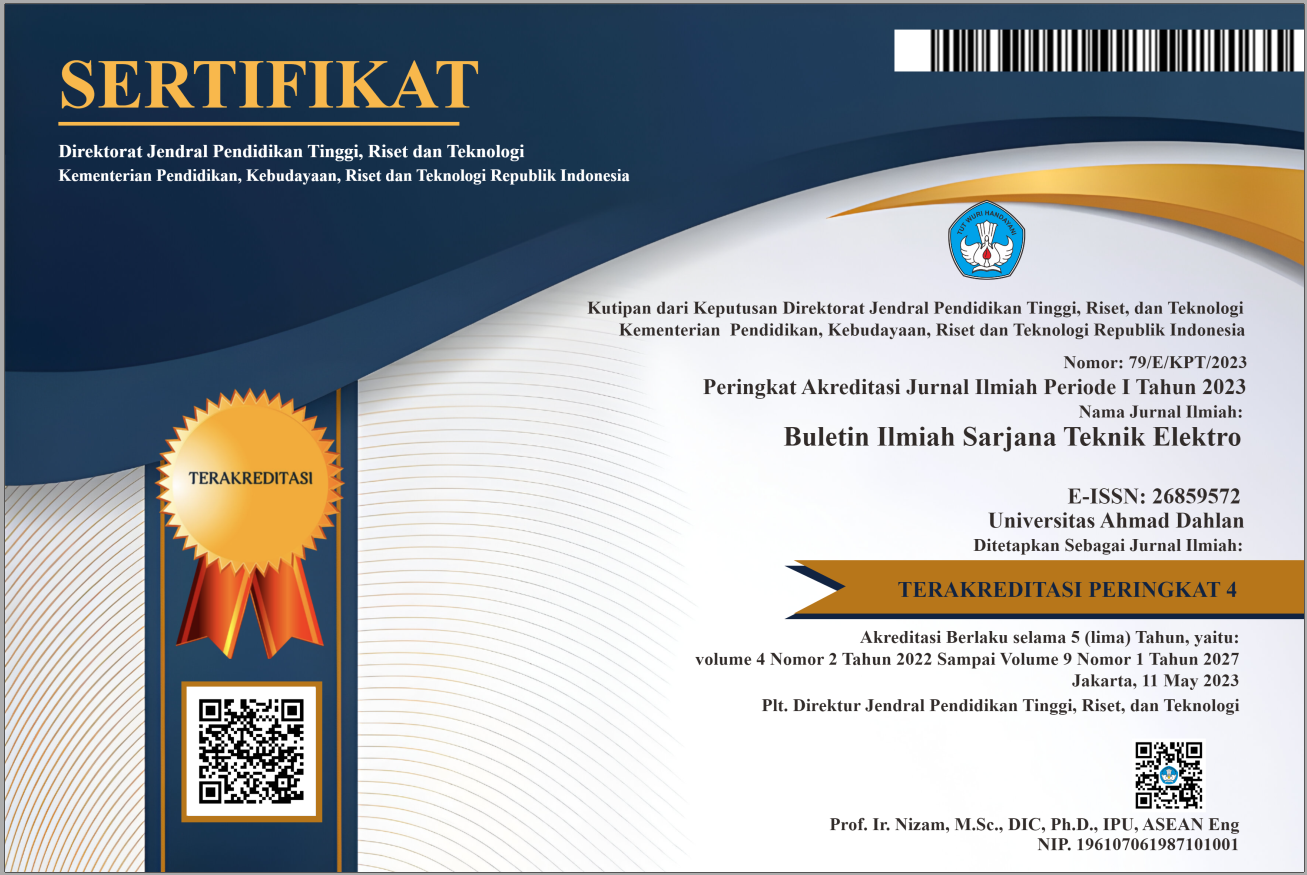Development of the Design and Control of a Hexapod Robot for Uneven Terrain
DOI:
https://doi.org/10.12928/biste.v5i4.9426Keywords:
Robot, Hexapod , Arduino, Uneven Terrain, AX-18AAbstract
In the Indonesian Search and Rescue Robot Contest in 2021 and 2022, the robot still cannot work well when passing through uneven obstacles. The change in uneven terrain from the previous year was a difficulty for the robot in passing it. This research was conducted to develop mechanical design and movement control design for the robot, so that the robot can be more optimal when moving through uneven terrain. The design of the hexapod robot is done by reducing the dimensions of the existing robot and determining the Center of Gravity point. The movement of the robot is also designed by determining the angular position of the AX-18A servo with respect to the terrain the robot travels through. The movement algorithm applied to the robot is the tripod gait algorithm. The robot control on the debris field and irregular floor is done by applying a proximity sensor to minimise the robot from hitting the wall on the field. The robot also has an IMU sensor that will work in measuring the slope on the up-and-down floor terrain (slope), so that the movement of the robot can be adjusted when passing through the terrain with the slope read by the sensor. The results of the research conducted show that the robot can be redesigned through 3D design through solidworks by determining the Center of Gravity (CoG) point. The robot has been able to pass through 3 objects tested, namely debris terrain, irregular floor terrain, and up and down floor terrain. The success rate of the robot when passing through debris terrain and irregular floor terrain is 100% with an average time of 9.7 seconds and 10.1 seconds. The success rate of the robot when passing through the up-and-down floor terrain is 80% with an average time of 22.9 seconds.
References
A. P. S. Prasojo, G. A. K. Surtiari, and P. Prasetyoputra, “The impact of natural disasters in Indonesia: How does welfare accentuate and attenuate the loss of people?,” J. Phys. Conf. Ser., vol. 1869, no. 1, 2021, https://doi.org/10.1088/1742-6596/1869/1/012148.
P. A. Ningrum, A. Hukom, and S. Adiwijaya, “The Potential of Poverty in the City of Palangka Raya: Study SMIs Affected Pandemic Covid 19,” Budapest International Research and Critics Institute-Journal (BIRCI-Journal) Volume, vo. 3, pp. 1626-1634, 2020, https://doi.org/10.33258/birci.v3i3.1094.
D. R. Hizbaron, D. Ruslanjari, and D. Mardiatno, “Amidst covid-19 pandemic: An adaptive disaster governance in Yogyakarta, Indonesia,” Soc. Sci., vol. 10, no. 3, 2021, https://doi.org/10.3390/socsci10030092.
M. T. Chaudhary and A. Piracha, “Natural disasters—origins, impacts, management,” Encyclopedia, vol. 1, no. 4, pp. 1101-1131, 2021, https://doi.org/10.3390/encyclopedia1040084.
E. Yulianto, D. A. Yusanta, P. Utari, and I. A. Satyawan, “Community adaptation and action during the emergency response phase: Case study of natural disasters in Palu, Indonesia,” Int. J. Disaster Risk Reduct., vol. 65, p. 102557, 2021, https://doi.org/10.1016/j.ijdrr.2021.102557.
J. A. Muir, M. R. Cope, L. R. Angeningsih, and R. B. Brown, “Community recovery after a natural disaster: Core data from a survey of communities affected by the 2010 Mt. Merapi eruptions in Central Java, Indonesia,” Data Br., vol. 32, p. 106040, 2020, https://doi.org/10.1016/j.dib.2020.106040.
N. Flores Quiroz, L. Gibson, W.S Conradie, P. Ryan, R. Heydenrych, A. Moran, A. van Straten, and R. Walls, “Analysis of the 2017 Knysna fires disaster with emphasis on fire spread, home losses and the influence of vegetation and weather conditions: A South African case study,” Int. J. Disaster Risk Reduct., vol. 88, p. 103618, 2023, https://doi.org/10.1016/j.ijdrr.2023.103618.
T. Santika, S. Budiharta, E. A Law, R. A Dennis, A. Dohong, M. J Struebig, MedrilzamH. Gunawan, E. Meijaard, and K. A Wilson., “Interannual climate variation, land type and village livelihood effects on fires in Kalimantan, Indonesia,” Glob. Environ. Chang., vol. 64, p. 102129, 2020, https://doi.org/10.1016/j.gloenvcha.2020.102129.
Arleiny, D. Purba, Ii. Suwondo, and M. Trinata P, “Analysis of search and rescue emergency evaluation in ship accidents in Indonesia,” SHS Web Conf., vol. 42, p. 00119, 2018, https://doi.org/10.1051/shsconf/20184200119.
T. Keerthika, M. Dhaarini, D. A. F. Arokiadoss, J. Danica and S. Iswarya, "Implementation of Robotics for Child Rescue from Bore Hole using Internet of Things," 2022 7th International Conference on Communication and Electronics Systems (ICCES), pp. 443-448, 2022, https://doi.org/10.1109/ICCES54183.2022.9835918.
N. T. Mohammed Saeed, C. Weber, M. Fathi, and K. D. Kuhnert, “An Efficient Alternative for Modeling Spatial Prepositions with RDF Helper Nodes Based on the Environment Perception of a Mobile Robot,” IEEE Int. Symp. Ind. Electron., pp. 1138–1143, 2019, https://doi.org/10.1109/ISIE.2019.8781421.
M. Najafi, K. Adams, and M. Tavakoli, “Robotic learning from demonstration of therapist’s time-varying assistance to a patient in trajectory-following tasks,” IEEE Int. Conf. Rehabil. Robot., pp. 888–894, 2017, https://doi.org/10.1109/ICORR.2017.8009361.
O. M. Ikumapayi, S. A. Afolalu, T. S. Ogedengbe, R. A. Kazeem, and E. T. Akinlabi, “Human-Robot Co-working Improvement via Revolutionary Automation and Robotic Technologies - An overview,” Procedia Comput. Sci., vol. 217, pp. 1345–1353, 2022, https://doi.org/10.1016/j.procs.2022.12.332.
J. Wu, S. Y. Tang, T. Fang, W. Li, X. Li, and S. Zhang, “A wheeled robot driven by a liquid-metal droplet,” Adv. Mater., vol. 30, no. 51, pp. 1–7, 2018, https://doi.org/10.1002/adma.201805039.
Z. Chen, S. Wang, J. Wang, and K. Xu, “Attitude stability control for multi-agent six wheel-legged robot,” IFAC-PapersOnLine, vol. 53, no. 2, pp. 9636–9641, 2020, https://doi.org/10.1016/j.ifacol.2020.12.2610.
I. Moreno-Caireta, E. Celaya, and L. Ros, “Model predictive control for a mecanum-wheeled robot navigating among obstacles,” IFAC-PapersOnLine, vol. 54, no. 6, pp. 119–125, 2021, https://doi.org/10.1016/j.ifacol.2021.08.533.
P. Cizek, M. Zoula, and J. Faigl, “Design, Construction, and Rough-Terrain Locomotion Control of Novel Hexapod Walking Robot with Four Degrees of Freedom per Leg,” IEEE Access, vol. 9, pp. 17866–17881, 2021, https://doi.org/10.1109/ACCESS.2021.3053492.
K. XU, S. WANG, J. WANG, X. WANG, Z. CHEN, and J. SI, “High-adaption locomotion with stable robot body for planetary exploration robot carrying potential instruments on unstructured terrain,” Chinese J. Aeronaut., vol. 34, no. 5, pp. 652–665, 2021, https://doi.org/10.1016/j.cja.2020.11.012.
S. Y. Misyurin, G. V. Kreinin, N. Y. Nosova, and A. P. Nelubin, “Six-Legged Walking Robot (Hexabot), Kinematics, Dynamics and Motion Optimization,” Procedia Comput. Sci., vol. 190, pp. 604–610, 2021, https://doi.org/10.1016/j.procs.2021.06.071.
Y. Murata, S. Inagaki, and T. Suzuki, “Development of an adaptive hexapod robot based on Follow-the-contact-point gait control and Timekeeper control,” IEEE Int. Conf. Intell. Robot. Syst., pp. 3321–3327, 2019, https://doi.org/10.1109/IROS40897.2019.8968158.
L. Fućek, Z. Kovačić, and S. Bogand, “Analytically founded yaw control algorithm for walking on uneven terrain applied to a hexapod robot,” Int. J. Adv. Robot. Syst., vol. 16, no. 3, pp. 1–17, 2019, https://doi.org/10.1177/1729881419857997.
N. Ukani, S. Chakole, S. S. B. Diwan, S. S. Kawale, and S. K. Hedau, “Developing Hexapod Robot,” ICACCS, pp. 1181–1184, 2020, https://doi.org/10.1109/ICACCS48705.2020.9074235.
K. Osman and T. Alajbeg, “Mathematical Model and Control Simulation of Hexapod Robot Locomotion in Tripod Gait,” in ECCOMAS Thematic Conference on Multibody Dynamics, pp. 322–332, 2021, https://doi.org/10.3311/ECCOMASMBD2021-152.
M. Zak, J. Rozman, and F. V. Zboril, “Design of Omni-directional Hexapod Robot with Horizontal Coxa Joint,” in INFORMATICS 2019 - IEEE 15th International Scientific Conference on Informatics, Proceedings, pp. 119–123, 2019. https://doi.org/10.1109/Informatics47936.2019.9119326.
Z. Zhou and X. Zhu, “Design and Simulation of Special Hexapod Robot with Vertical Climbing Ability,” in Proceedings of 2020 IEEE 5th Information Technology and Mechatronics Engineering Conference, ITOEC 2020, pp. 741–744, 2020, https://doi.org/10.1109/ITOEC49072.2020.9141755.
Z. Nasution, A. F. Ilham Suparman, G. A. Prasetyo, A. H. Alasiry, E. H. Binugroho, and A. Darmawan, “Body Balancing Control for EILERO Quadruped Robot while Walking on Slope,” IES 2019 - Int. Electron. Symp. Role Techno-Intelligence Creat. an Open Energy Syst. Towar. Energy Democr. Proc., pp. 364–369, 2019, https://doi.org/10.1109/ELECSYM.2019.8901598.
M. Nitulescu, M. Ivanescu, V. D. H. Nguyen, and S. Manoiu-Olaru, “Designing the legs of a hexapod robot,” 2016 20th Int. Conf. Syst. Theory, Control Comput. ICSTCC 2016 - Jt. Conf. SINTES 20, SACCS 16, SIMSIS 20 - Proc., pp. 119–124, 2016, https://doi.org/10.1109/ICSTCC.2016.7790651.
J. Sun, J. Ren, Y. Jin, B. Wang, and D. Chen, “Hexapod Robot Kinematics Modeling and Tripod Gait Design Based on the Foot End Trajectory,” in International Conference on Robotics and Biomimetics, pp. 2611–2616, 2017, https://doi.org/10.1109/ROBIO.2017.8324813.
R. Barrio, Lozano, M. A. Martínez, M. Rodríguez, and S. Serrano, “Routes to tripod gait movement in hexapods,” Neurocomputing, vol. 461, pp. 679–695, 2021, https://doi.org/10.1016/j.neucom.2020.06.151.
H. Antono, L. M. Robbi, E. S. Ningrum, and D. S. Purnomo, “Design, stress analysis and determination of center of gravity on stair climber wheelchair,” Proc. IES-ETA 2017 - Int. Electron. Symp. Eng. Technol. Appl., pp. 118–122, 2017, https://doi.org/10.1109/ELECSYM.2017.8240389.

Published
How to Cite
Issue
Section
License
Copyright (c) 2023 Prasetya Murdaka Putra, Nuryono Satya Widodo

This work is licensed under a Creative Commons Attribution-ShareAlike 4.0 International License.
Authors who publish with this journal agree to the following terms:
- Authors retain copyright and grant the journal right of first publication with the work simultaneously licensed under a Creative Commons Attribution License that allows others to share the work with an acknowledgment of the work's authorship and initial publication in this journal.
- Authors are able to enter into separate, additional contractual arrangements for the non-exclusive distribution of the journal's published version of the work (e.g., post it to an institutional repository or publish it in a book), with an acknowledgment of its initial publication in this journal.
- Authors are permitted and encouraged to post their work online (e.g., in institutional repositories or on their website) prior to and during the submission process, as it can lead to productive exchanges, as well as earlier and greater citation of published work (See The Effect of Open Access).
This journal is licensed under a Creative Commons Attribution-ShareAlike 4.0 International License.


